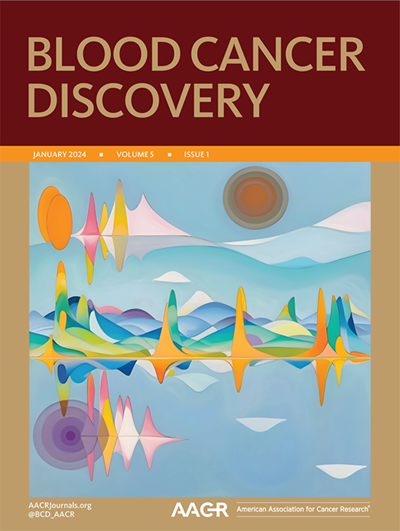Selective Enhancer Dependencies in MYC-Intact and MYC-Rearranged Germinal Center B-cell Diffuse Large B-cell Lymphoma.
IF 11.5
Q1 HEMATOLOGY
引用次数: 0
Abstract
Significance: Aberrant MYC activity defines the most aggressive GCB-DLBCLs. We characterized a mechanism of MYC transcriptional activation via a native enhancer that is active in MYC-intact GCB-DLBCL, establishing fitness-sustaining cis- and trans-regulatory circuitry in GCB-DLBCL models that lack MYC enhancer-hijacking rearrangement. See related commentary by Mulet-Lazaro and Delwel, p. 149.
myc -完整和myc -重排生发中心b细胞弥漫性大b细胞淋巴瘤的选择性增强子依赖性
MYC及其靶基因的高表达鉴定了生发中心b细胞弥漫性大b细胞淋巴瘤(GCB-DLBCL)与不良预后相关。我们使用人类淋巴瘤细胞系的crispr干扰分析来定义MYC基因座和非免疫球蛋白重排伴侣基因座的基本增强子,包括MYC和BCL6基因座控制区之间的复发性重排。没有MYC重排的GCB-DLBCL细胞系依赖于一种进化保守的增强子,我们将其命名为“生发中心MYC增强子1”(GME-1),该增强子由OCT2、OCA-B和MEF2B的转录因子复合物激活,在正常的人和小鼠生发中心B细胞中显示出活跃的染色质状态,并在MYC完整的GCB-DLBCL活组织检查中显示出选择性乙酰化和MYC启动子拓扑相互作用。全基因组测序发现,GME-1增强子的串联拷贝增益是DLBCL中罕见但反复发生的事件。我们的发现揭示了MYC失调的机制,MYC是B细胞恶性肿瘤的关键驱动因素。
本文章由计算机程序翻译,如有差异,请以英文原文为准。
求助全文
约1分钟内获得全文
求助全文
来源期刊

Blood Cancer Discovery
Multiple-
CiteScore
12.70
自引率
1.80%
发文量
139
期刊介绍:
The journal Blood Cancer Discovery publishes high-quality Research Articles and Briefs that focus on major advances in basic, translational, and clinical research of leukemia, lymphoma, myeloma, and associated diseases. The topics covered include molecular and cellular features of pathogenesis, therapy response and relapse, transcriptional circuits, stem cells, differentiation, microenvironment, metabolism, immunity, mutagenesis, and clonal evolution. These subjects are investigated in both animal disease models and high-dimensional clinical data landscapes.
The journal also welcomes submissions on new pharmacological, biological, and living cell therapies, as well as new diagnostic tools. They are interested in prognostic, diagnostic, and pharmacodynamic biomarkers, and computational and machine learning approaches to personalized medicine. The scope of submissions ranges from preclinical proof of concept to clinical trials and real-world evidence.
Blood Cancer Discovery serves as a forum for diverse ideas that shape future research directions in hematooncology. In addition to Research Articles and Briefs, the journal also publishes Reviews, Perspectives, and Commentaries on topics of broad interest in the field.
 求助内容:
求助内容: 应助结果提醒方式:
应助结果提醒方式:


